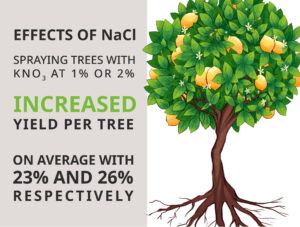The effects of various rates and frequencies of foliar potassium nitrate and potassium sulphate on fruit production and quality parameters of citrus clementine were studied. The experiment was located in the Gharb plain of Morocco. The soil type was clay and the citrus clementine variety used was Cadoux, grafted on citrange Carizzo, trees were 23 years old. Application rates of tested foliar fertilizers were 5% and 8% KNO3, and 2,5% and 4% K2SO4, applied either two or three times during fruit growth on orchards of three planting densities (D1: 6 m x 6 m, D2: 5 m x 6 m and D3: 6 m x 3,5 m tree spacing). The control was sprayed with water alone. The dates of foliar applications were as follows: July 16, August 3 and August 21, 2007. At a given application date, each tree was sprayed with ten liters of the foliar K fertilizer.
The high K concentration treatments in three sprays were most effective in increasing fruit size of clementine fruit. At low density (D1), 8% KNO3 in two or three foliar applications, proved most effective in improving average fruit weight compared to the control. The treatment 8% KNO3 in 3 applications gave the highest percentage of fruit in de extra-large sized class in all planting densities (table 1). Trees sprayed with only two foliar sprays were markedly less effective in improving fruit size compared with three applications.
Table 1. Distribution of fruit number (%) of clementine in the largest size class in response to foliar K fertilization for the low (D1), medium (D2) and high (D3) planting density.

Potassium nitrate applications were more effective than potassium sulphate in terms of improving fruit color and total soluble sugar (TSS) content of the fruit. Concerning the effect of foliar K fertilisation, the results clearly demonstrated that raising the K concentration and the number of foliar sprays increased tree fruit yield. 8% KNO3 and 4% K2SO4treatments were most effective in improving fruit yield. The largest gain in production of 12-13 MT/ha over the control was found with 3 sprays of 8% potassium nitrate (Figure 1). Spraying 8% KNO3 resulted in the highest yield for all three planting densities compared to other K treatments with three applications.

Figure 1. The effect of three foliar applications on clementine fruit yield for the low (D1), medium (D2) and high (D3) planting density.



